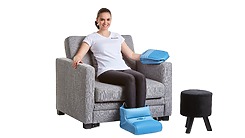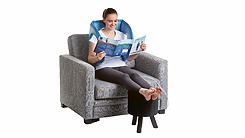Biomag - Encyclopedia - Pain
Pain - symptoms, description and treatment

Author MUDr. Peter Bednarčík CSc.
Revision
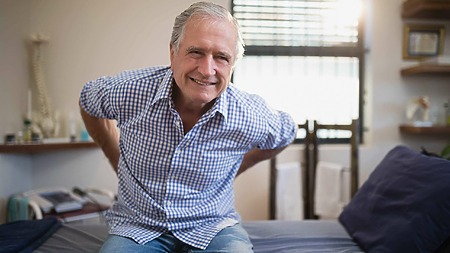
Lucky are those who haven’t experienced the struggle with pain. It can be both distressing and “tricky”, as it takes many forms and brings various limitations in everyday life. Whether your soreness is the result of an injury, a chronic condition or a mystery to you, don’t underestimate it. Don’t suffer unnecessarily and look for solutions.
Find out what options there are to relieve your pain and other symptoms that accompany many ailments! Read more here.
Symptoms of pain
- Physical sensation such as stinging, cramping, burning.
- Limited mobility.
- Increased sensitivity to touch or pressure.
- Swelling and redness.
- Trouble sleeping.
- Behavioural changes.
Hurting means discomfort and unpleasant sensation. It is individual and subjective, which means that it can manifest itself differently in each person.

Only a doctor can make a correct diagnosis. Do not use this or any other article on the internet to make a diagnosis. Do not delay seeing a doctor and address your condition early.
Pain – description and causes
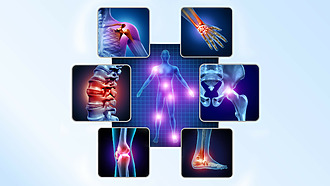
Pain – what is it?
It is a signal from the nervous system that indicates that something is wrong in the body.
It may occur in a specific place or part of the body, but whole-body soreness is no exception. It varies in form, intensity and duration.[1]
Types of pain
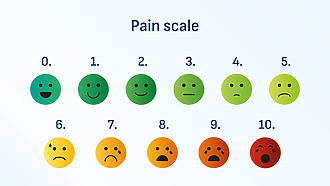
It is generally referred to as acute or chronic. It can be of varying character – sharp, dull, burning, throbbing, stabbing, clenching, shooting. It may be accompanied by a prickling sensation, tingling or weakness.
Its intensity is most often rated on a 10-point scale – 0 being pain-free and 10 being the worst possible pain.[2]
Acute and chronic pain
Acute pain (short-term) is the body’s reaction to a sudden stimulus and is usually sharp and intense. It can last for several minutes or days. Acute does not last more than a few weeks. It will subside the moment its cause is resolved or cured.[3]
Chronic pain (long-term) lasts longer than 12 weeks. It can persist or return repeatedly for several years despite treatment or care[4].
Causes of pain
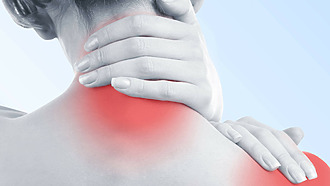
Soreness can have various causes:
- minor injuries(cuts, punctures),
- major injuries (fractures, bruises, dislocations, burns, etc.),
- acute or chronic diseases,
- degenerative processes,
- medical interventions.[5],[6]
It may have a psychosomatic origin. In this case, they are not caused solely by the injury or illness, but also involve the patient’s psyche (e.g. stress, anxiety or depression). [7]
Most painful diagnoses include:
- arthritis (the most common symptom is joint pain),
- fibromyalgia (the main symptom is muscle pain),
- sciatica (patients report sciatic nerve pain),
- diseases of the spine (for example, a prolapsed intervertebral disc that causes back ache),
- migraine (specific headache).
However, it is also common in heart disease (chest pain) and many musculoskeletal conditions (shoulder pain, lumbar spine pain, knee pain or hip pain). Chronic may occur in diabetes mellitus, which is accompanied by leg ache[8].
There is also abdominal pain, tooth and jaw pain, and growing pains.[9]
Diagnostics
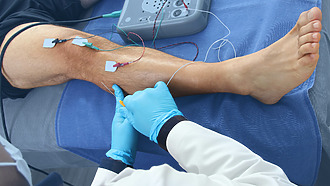
Pain in and of itself is not a diagnosis. It is a symptom of a disease, so it is important to look for their cause. It is a subjective matter, each patient perceives it differently, and diagnosis can be challenging, especially in chronic cases. What happens if you go to the doctor?
- The doctor will ask you everything you can say about the soreness – where and how often it occurs, how severe it is and how much it affects your daily life. It is important to find out what makes it worse and when it stops.
- Be sure to tell your doctor whether you have had any serious illnesses, injuries or operations in the past and whether you are taking any medication.
- After the conversation with the doctor, various examinations come next.
Basic examinations include laboratory analysis of blood and urine, physical examination (through looking, palpatory examination, listening, tapping etc.) and various imaging methods (X-ray, magnetic resonance imaging, computed tomography). Depending on the type of problem, the physician may recommend various neurological examinations, muscle and reflex activity checks, or other specialized tests.[10]
Did you know?
- Chronic pain management that combines different treatments can usually reduce soreness by 30%.[11]
- Physical activity helps with soreness by releasing endorphins (hormones that induce a feeling of well-being and relieve it).[12]
- In Western countries, up to 25% of the adult population reports chronic pain.[13]
Complications when left untreated
Not treating soreness can lead to a number of complications.
- Acute pain that is not treated can become chronic.
- Long-term pain may lead to weakening of the muscles.
- Chronic pain can have a significant impact on mental health.
- If it is only mitigated by medication, it may lead to addiction in some cases.
Chronic pain
Muscle weakness
Psychological complications
Addiction to medication

We recommend not delaying treatment for pain
Do not delay treatment for pain and see a specialist if you have any health problems or doubts about your health. This will prevent unnecessary health complications.
Pain therapy
Pain treatment depends primarily on its origin. However, the cause may not always be obvious, which is why doctors commonly combine different methods of therapy. If the chronic cause cannot be discovered or resolved, treatment focuses on alleviating it and promoting quality of life. When treating soreness, the psychological state must also be taken into account, as anxiety, stress or depression can exacerbate chronic pain.
Therapy often uses:
- medicaments,
- regimen measures,
- various types of therapy.

Beware
Pain treatment can only be determined by your doctor after considering your overall health. Therefore, do not use this article as a guide to treatment, which can only be determined by a doctor.
Pain medication
The most commonly used drugs are anticonvulsants (known as antiepileptics), which work well for chronic pain, anti-inflammatory drugs or analgesics, and strong analgesics (opioids). Corticosteroids and muscle relaxants are also used. Doctors commonly prescribe antidepressants. Sedatives are used for concomitant sleep disorders or anxiety. Another option is medical cannabis. When taking medication for a long time, it is necessary to take into account possible side effects and interactions with other medications taken.[14]
Pain – regimen measures
Four basic regimen measures play an important role in treatment.
- Try to minimize stress. There are various meditation techniques or breathing exercises.
- Seek activity. Low-impact activities such as walking or swimming can reduce their intensity.
- Eat healthily. A balanced diet with plenty of foods that reduce inflammation contributes to the body’s recovery.
- Mind a good night’s sleep. Without enough quality sleep, the body reacts less well to various stimuli.[15]
What therapy can help with pain?
Treatment is often a vicious circle. Sorness brings limitations in working life and in normal daily activities, which often leads to the development of depressive disorders and sleep disturbances. Such a condition in itself worsens the perception of soreness and the patient thus falls into an unpleasant spiral.
- Cognitive behavioural therapy can teach patients how to manage soreness.
- Psychological counselling is particularly effective for soreness that has no organic cause.
- In occupational therapy, patients learn how to perform normal activities correctly without aggravating their pain.
- Physiotherapy promotes mobility, flexibility and muscular strength and contributes to the well-being of the musculoskeletal and nervous system through various methods.[16]
Alternative pain treatment options
Alternative treatments can provide pain relief when combined with the other treatments mentioned above. Although they do not reveal the cause, they have the potential to significantly improve the quality of life of patients with chronic pain.
Pain – alternative treatment options:
- According to the latest findings, acupuncture can relieve lower back sche and arthritic joint pain in particular.
- Massages have a short-term effect, but they bring relief and have a relaxing effect.[17]
- Aromatherapy uses essential oils and their positive effects on the body and mood. They are used in massages, baths or inhalation.
- There are various psychological practices aimed at understanding one’s own body, calming down or practising correct breathing.[18]
Prevention and self-treatment
Chronic pain is often associated with diseases, the occurrence of which can be minimized by appropriate prevention. Preventive measures can therefore be considered to include:
- the right weight without being overweight or obese,
- reducing or stopping smoking,
- regular physical activity,
- adherence to ergonomic principles at work and in leisure time,
- mental health care.
As part of self-treatment and the search for appropriate relief, it is possible to try various stretching exercises, cold or warm compresses and individual relaxation techniques.[19]
Life with pain
Lifestyle changes can be a major breakthrough in your current treatment. It is worth taking equal care of the body and mind, as the two are strongly intertwined in chronic pain.
- Don’t forget the basics such as quality sleep, rest from work and positive thinking.
- Don’t try to get all your responsibilities done at all times and try to prioritise.
- Alcohol is not a good way to relieve pain; on the contrary, it can aggravate it and cause further problems.
A healthy diet and regular exercise are proven to be beneficial for the body. A nutritional therapist can help with specific dietary changes, a physiotherapist or personal trainer can help with appropriate exercise.[20],[21]

Important information when dealing with pain
- It can be acute or chronic.
- To determine the appropriate treatment, it is necessary to determine its cause. If the origin cannot be detected, therapy is focused on alleviating it.
- For chronic pain, different treatments are usually combined – for example, medication and regimen measures.
Summary and recommendations for managing pain
See your physician
Treatment for pain is always determined by your doctor based on a general examination, an assessment of your condition and an accurate diagnosis.
Causal treatment of pain
After a general examination, your doctor will recommend treatment for the cause of soreness. In connection with this, he will also recommend possible lifestyle modification and further courses of action.
Relieving pain, swelling and inflammation
Symptomatic treatment focuses on the manifestations or symptoms of the disease. Such treatment can significantly improve your quality of life and support comprehensive treatment as the disease progresses.
Sources, references and literature
[1] Laguipo A. Chronic Pain: The 20 Most Painful Conditions. News-Medical, 7. September 2023. Available at: https://www.news-medical.net/health/Pain-Acute-Pain-Chronic-Pain-20-Most-Painful.aspx
[2] Chronic Pain. Cleveland Clinic, 1. September 2021. Available at: https://my.clevelandclinic.org/health/diseases/4798-chronic-pain
[3] What is Acute Pain. The International Association for the Study of Pain. Available at: https://www.iasp-pain.org/resources/topics/acute-pain/
[4] Chronic pain. NHS inform, 10. May 2023. Available at: https://www.nhsinform.scot/illnesses-and-conditions/brain-nerves-and-spinal-cord/chronic-pain
[5] Laguipo A. Chronic Pain: The 20 Most Painful Conditions. News-Medical, 7. September 2023. Available at: https://www.news-medical.net/health/Pain-Acute-Pain-Chronic-Pain-20-Most-Painful.aspx
[6] Chronic Pain. Cleveland Clinic, 1. September 2021. Available at: https://my.clevelandclinic.org/health/diseases/4798-chronic-pain
[7] Chronic Pain. Cleveland Clinic, 1. September 2021. Available at: https://my.clevelandclinic.org/health/diseases/4798-chronic-pain
[8] Laguipo A. Chronic Pain: The 20 Most Painful Conditions. News-Medical, 7. September 2023. Available at: https://www.news-medical.net/health/Pain-Acute-Pain-Chronic-Pain-20-Most-Painful.aspx
[9] Laguipo A. Chronic Pain: The 20 Most Painful Conditions. News-Medical, 7. September 2023. Available at: https://www.news-medical.net/health/Pain-Acute-Pain-Chronic-Pain-20-Most-Painful.aspx
[10] Chronic Pain. Cleveland Clinic, 1. September 2021. Available at: https://my.clevelandclinic.org/health/diseases/4798-chronic-pain
[11] Chronic Pain. Cleveland Clinic, 1. September 2021. Available at: https://my.clevelandclinic.org/health/diseases/4798-chronic-pain
[12] 11 Tips for Living With Chronic Pain. WebMD, 14. January 2023. Available at: https://www.webmd.com/pain-management/11-tips-for-living-with-chronic-pain
[13] Chronic Pain. Cleveland Clinic, 1. September 2021. Available at: https://my.clevelandclinic.org/health/diseases/4798-chronic-pain
[14] Chronic Pain. Cleveland Clinic, 1. September 2021. Available at: https://my.clevelandclinic.org/health/diseases/4798-chronic-pain
[15] Chronic Pain. Cleveland Clinic, 1. September 2021. Available at: https://my.clevelandclinic.org/health/diseases/4798-chronic-pain
[16] Chronic Pain. Cleveland Clinic, 1. September 2021. Available at: https://my.clevelandclinic.org/health/diseases/4798-chronic-pain
[17] Rushlow A. Chronic Pain Relief: New Treatments. WebMD, 17. May 2016. Available at: https://www.webmd.com/pain-management/features/chronic-pain-relief-new-treatments
[18] Chronic Pain. Cleveland Clinic, 1. September 2021. Available at: https://my.clevelandclinic.org/health/diseases/4798-chronic-pain
[19] Chronic Pain. Cleveland Clinic, 1. September 2021. Available at: https://my.clevelandclinic.org/health/diseases/4798-chronic-pain
[20] Chronic Pain. Cleveland Clinic, 1. September 2021. Available at: https://my.clevelandclinic.org/health/diseases/4798-chronic-pain
[21] Chronic pain. NHS inform, 10. May 2023. Available at: https://www.nhsinform.scot/illnesses-and-conditions/brain-nerves-and-spinal-cord/chronic-pain
| Rate this article |
|
|
5/51 Reviewed by
|
How to control pain, swelling and address inflammation?
The solution may be symptomatic treatment using pulsed magnetic therapy (PEMF therapy), which targets symptoms and signs such as pain, swelling and inflammation. In addition, such treatment can support comprehensive treatment and significantly improve quality of life.
Explaining the effects
The basic principle of Biomag 3D pulsed magnetic therapy (PEMF therapy) is the generation of electromagnetic pulses. These pulses penetrate through clothing and through the entire depth of the tissue to the point of targeted application. The pulses have specially developed biotropic parameters (e.g. frequency, shape, intensity) to best affect various health problems.
What are the effects of 3D magnetic therapy (PEMF therapy)?
- Helps relieve pain.
- Mitigates inflammation.
- Suppresses swelling.
How is the treatment applied?
The application is very simple. You select the desired therapeutic effect on the device and attach the supplied applicator to the desired application site. Magnetic therapy is usually applied 2 times a day for 20 minutes.
We will be happy to help you try this method and advise you on which device to purchase.

